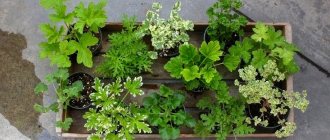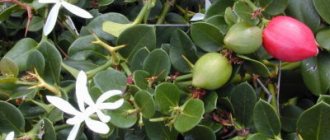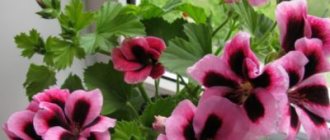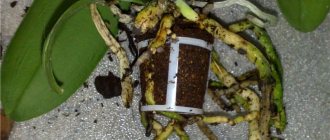Formation of a geranium crown (video)
Spring pruning and pinching perform an important agrotechnical function - they stimulate the formation of new buds, branches and inflorescences.
It is important to remember: after spring pruning and/or pinching, the geranium will bloom later.
The explanation for this is simple: the flower needs time to recuperate. Therefore, you need to decide what you want to achieve: early flowering or its lushness and longevity. If you consider that pinching is a more gentle procedure than pruning, then in the spring you can choose the first option. Young shoots need to be pinched not only in the spring, but also as the plant grows.
Geranium requires constant monitoring by the grower over the growth of shoots and the removal of unnecessary shoots
Unless strictly necessary, pruning in the spring may not be carried out. You can trim only up to 20% of all shoots. Extensive thinning can significantly delay flowering time. Also, the plant may spend all its energy recovering from stress and not bloom at all this season.
Care after work: table
Geraniums that have suffered spring pinching or pruning need the most favorable conditions.
Why do geraniums need a haircut?
Every spring we can see how bushes and trees are trimmed on the central streets of the city, giving them the correct shape. But few people realize that this haircut is not only decorative. Plants are pruned to improve the health and rejuvenation of the crown. The same applies to indoor specimens prone to intensive growth, such as pelargonium (geranium).
Purpose and benefits of pruning
The main purpose of pruning any plant is to thin the crown to improve air exchange, lighting and leaf nutrition. Without this event, the geranium will have a neglected and unhealthy appearance, will stop blooming, and will turn into a shapeless and unkempt bush.
- flowering period is extended;
- more lateral branches and young shoots are formed;
- wintering becomes easier.
metabolism accelerates and its quality improves;
The flowering time of geraniums depends on the variety and occurs from early spring to late autumn, and in some varieties even in winter. In order to have a lot of inflorescences on the plant, it is necessary to prune the bush, but do it correctly and in a timely manner, according to the characteristics of the variety.
To form a beautiful bush and lush color, geraniums need regular pruning.
Autumn pruning is a more logical procedure than spring pruning. From November to February, geraniums begin their dormant period. The plant often slows down its development while continuing to feed. In this state it is very difficult to maintain a lush crown, but cutting it makes wintering much easier. Drastic pruning allows pelargonium to refresh the crown and re-form the bush.
If your pelargonium blooms all year round, then you can cut it at any time.
In winter, geraniums can be trimmed only if there are conditions for maintaining the trimmed flower; at least two lower leaves are left. After the crown of the plant has rejuvenated due to radical pruning, its bush can be formed during the winter by pinching and decorative pruning. Zonal pelargonium has the peculiarity of rapid budding and early formation of buds, so it will only be happy to be trimmed;
- ivy-leaved pelargonium can be cut in both spring and autumn. If the bush becomes excessively elongated during the winter, it is trimmed at the end of February - beginning of March;
- Flower growers cut ampelous geraniums at their own discretion; if the plant does not need pruning, then it is not touched until spring;
- the variegated species is difficult to tolerate autumn pruning; it is easier for them to go through such stress in the spring;
- mini-varieties of geraniums are not cut at all. The crown of these tiny pelargoniums is adjusted only for reasons of beauty and decorativeness of the bush;
- Royal pelargonium is trimmed “under the stump” and placed in a cool place. But such a drastic pruning is not done regularly, but only when necessary, because the plant does not develop as intensively as, for example, zonal geranium.
Photo gallery: geranium varieties
Video: crown formation of geraniums in winter
Geranium diseases and care errors
In principle, caring for geraniums outdoors is no different from indoor procedures. The same applies to plant diseases and their treatment.
Most often, the bush is affected by the following diseases:
- The base of the stem turns black and rots when the flower is infected with a disease called “blackleg.” The causes of infection are hypothermia of the roots and waterlogging of the soil. Unfortunately, it will not be possible to save the bush. It will have to be thrown away along with the soil, and the pot will have to be disinfected.
- White coating or cobwebs on the leaves is gray mold. The disease appears with excessive watering, poor drainage and the use of a heavy substrate. Antifungal drugs are used for treatment.
- Reddish-yellow spots on the leaf blades that form stripes are “rust,” namely a fungal disease. The disease appears due to irregular and uneven watering, as well as excessive air humidity. For the purpose of treatment, the affected shoots and leaves are removed. The flower is sprayed with fungicide solutions three times with an interval of 10 days.
- Whitish spots that enlarge and turn brown in the future are powdery mildew. It appears in conditions of high humidity and temperature or due to an excess of nitrogenous fertilizers. For treatment, the room is regularly ventilated, the flower is not fertilized. The leaves are sprayed with a solution of fungicides or a mixture of water, milk and iodine.
https://youtube.com/watch?v=4_EaN6cP6Pc
Geranium doesn't bloom
Sometimes geraniums stop flowering. If the flower is watered too often, geranium flowers will not form or will begin to fall off without opening. If the plant overwinters in a hot room, then new buds simply do not form. Also, buds do not form due to lack of lighting or excessive pruning in winter.
To ensure flowering, the bush is pruned in a timely manner, placed in a cool room for the winter, and in the spring the daylight hours are extended due to artificial lighting. Nitrogenous fertilizers can also prevent abundant flowering.
The leaves have turned yellow
Most often, yellowed leaves indicate a lack of water, so to solve the problem, increase the frequency of watering. You should not overdo it with moistening the soil, so that the roots do not begin to rot and lead to a similar problem with yellowing of the foliage.
Geranium leaves drying out
The main reason why the leaves of zonal geraniums dry and turn yellow is due to the natural growth and elongation of the stem. If the leaf plates dry out at the edges, then the reason lies in a lack of nutrition.
Spots appeared on the leaves
Any spots on the leaves indicate the presence of pests. Leaf plates also turn yellow when infected with whiteflies or rotting by the root system
It is important to identify the provoking factor and eliminate it
How to form pelargonium in the fall
You can’t just pick up and trim plants. In addition to a certain algorithm of actions, there are rules that are important to follow for the sake of a successful outcome of the event.
Step-by-step instruction
- If geranium is kept in the garden or on the balcony all summer, before autumn pruning it must be brought indoors a couple of weeks before the procedure (in order to give the plant time to get used to the new conditions). If you prune a flower right away, the bush will experience severe stress and get sick without having time to acclimatize.
Pelargonium, accustomed to outdoor maintenance, must be acclimatized indoors before the pruning procedure.
The blade can be treated with any disinfectant
The cut should not be torn
Before radical pruning, you can thin out the bush for convenience.
Also, flower growers often use ordinary brilliant green for disinfection.
It is important to trim a geranium branch above a leaf node, and the cut can be treated with regular green paint
Transfer rules
Royal geranium has a very unfavorable attitude towards various movements. Transplantation is carried out in exceptional cases. It is better not to disturb the plant at all. But it happens that you still have to seat them. For example, there may be cases in which the root system has grown so intensely that it simply no longer fits into the pot. In this case, of course, the plant must be replanted.
Transplantation is recommended every 2 years. If this requirement is not met, the plant may stop flowering or there will be a small number of flowers. The optimal time for transplantation is the very beginning of February. The soil should be prepared, which will consist of peat, deciduous soil, turf soil and river sand. Good drainage is essential. Expanded clay or river sand are best suited for this purpose.
Pruning geraniums - in autumn, for winter, for lush flowering
Unpretentious geranium is a home flowering plant. For many years it has been popular among indoor plant lovers. These are also beautiful balcony flowers and can often be found on terraces, balconies or garden beds.
They require proper care to grow properly. In addition to fertilizing and watering, the plant needs to be pruned regularly. Pruning geraniums for lush flowering is an important step in care. It prevents stretching, makes the crown fluffy and very beautiful.
Features of flowering
It is not for nothing that geraniums with large (simple or double) flowers are given royal status. Seeing flowers of all shapes and colors collected in umbrellas, it is impossible to pass by. Royal varieties do not bloom as long and require more care.
They reach a height of 30 to 70 cm and differ from other species:
- voluminous, up to 7-8 cm in diameter, flowers;
- corrugated leaves with a rough surface and jagged edges.
Important. The royal type of geranium is the most capricious; if you do not water regularly, you will never be able to wait for flowering.
Purpose and benefits of pruning
The species diversity of geranium is amazing. She feels great both at home and in open ground conditions. Proper pruning ensures regular flowering with a large number of inflorescences. When starting to form a plant, it is important to know how to prune geraniums correctly and how to form a bush. Detailed answers to these questions are provided below.
Purposes of pinching geraniums:
- activation of lateral branching;
- formation of new inflorescences;
- giving geraniums a beautiful shape;
- ensuring long-term flowering;
- obtaining seedlings for propagation.
Correct and timely pinching of geraniums allows you to activate the lateral vegetative buds. Without outside help they will remain dormant. After pruning pelargonium, the lateral buds begin not only to form new shoots, but also take part in the formation of inflorescence primordia.
When to prune geraniums:
- in spring - the main type of pruning, which is necessary for voluminous flowering;
- in autumn - a preventive procedure to remove dead, diseased and dry parts;
- pinching is a type of pruning that can be done at any time if the need arises.
Important! Geraniums should be pruned regularly to ensure they bloom on time. Otherwise, flowering may be delayed or not occur at all.
Winter pruning
Experienced flower growers note that on short winter days, in the absence of sunlight, royal geranium grows tall. At this time, pruning for lush flowering is partially replaced by pinching, and long emerging shoots are cut off.
In April, royal pelargonium begins to bloom, so pruning should be stopped in mid-March. To maintain the shape of the bush, pinching can be done in the summer, after flowering. It is strictly not recommended to prune geraniums from December to February, so as not to disturb the dormant period. In winter, the plant rests. At this time, it requires minimal watering and a lighted, cool (temperature no higher than 15 degrees) place.
Crown formation in winter
The winter months are a dormant time for geraniums. Short daylight hours and lack of solar energy send this indoor flower into hibernation.
- does not bloom;
- does not give active growth;
- does not form new shoots.
As a rule, there is no need for pruning in winter. During this period, you need to monitor the condition of the geranium. Particular attention should be paid to shoots that were pruned in the fall. If the cut areas begin to turn black or rot, then the affected area should be cut off.
If the need arises, the time for the main pruning can be postponed to the second half of February. However, if possible, it is better to postpone this procedure until March.
Before the onset of winter, it is recommended to tame all shoots by at least 1/3. This allows you to activate kidneys that are in an inactive state. This procedure has a beneficial effect on the formation of geraniums.
Why doesn't geranium bloom, but only produces foliage?
The reasons for this may be the following factors:
- Incorrectly selected pot. If the container is cramped, the roots will devote all their energy to the growth of new shoots rather than the formation of flowers. In a cramped pot, the plant begins to actively grow upward; the leaves are large, but sparsely spaced.
- Incorrectly selected fertilizers and violation of the feeding schedule. If you fertilize the plant too often, it will cause the leaves to grow quickly. Flowering may not occur due to lack of nutrients.
- Excessive moisture. Despite the fact that geranium loves moist soil, frequent watering leads to the formation of green mass without buds. In autumn, the plant needs to be watered less frequently, otherwise this may also negatively affect the appearance of inflorescences.
- No trimming. With a large accumulation of shoots, the root system does not have enough nutrients to bloom. It is especially necessary to carefully monitor the appearance of young shoots, which can take away all the strength of an adult bush.
- Root damage. Root diseases lead to a lack of buds and can contribute to the death of the plant.
- Lack of light. In the shade, the plant will reach for the light and become weak. Such bushes almost never bloom.
- Pest infestation. Insects reduce the vigor of the plant, so it cannot bloom.
- Low air temperature. Such situations arise in winter. Geranium tolerates hot conditions well, but a decrease in temperature can lead to a lack of flowering.
Why doesn't it bloom, but only forms foliage?
Some plant varieties have their own characteristics. For example, the question often arises as to why royal geraniums do not bloom. This variety, unlike other varieties, has a lush bush that requires special pruning and care. Flowering of a crop may not begin for the following reasons:
- due to lack of light;
- if the pot is too large;
- with frequent and incorrect pruning;
- if the plant is not transplanted into new soil in a timely manner;
- placing the geranium in the shade - in this case, the buds form, but fall off without blooming.
Why doesn't royal geranium bloom?
Important! To choose the optimal place in the house for growing geraniums, you need to move the pot. Very often, after a change of location, the plant begins to actively bloom.
How to form pelargonium in the fall?
Houseplant lovers need to know how to prune geraniums in the fall. To get a good result, it is important to strictly follow the pruning rules.
Step-by-step instruction:
- carefully examine the flower - you need to determine which unnecessary parts will be removed;
- all instruments used to make cuts must be disinfected - boiled, calcined or treated with an alcohol solution;
- Before the procedure, you must wash your hands well (preferably with soap) and wear silicone (rubber) gloves. This step is necessary to prevent the risk of infection of the plant through the pinching site;
- remove all dry parts from the plant (old inflorescences, leaves, stems and twigs);
- remove parts that may become a source of disease or have a suspicious appearance;
- remove all stems that are too stretched upward, these include shoots that have more than 5 vegetative buds;
- treat the removal sites with a special disinfectant solution.
Before pruning geraniums in the fall, you need to make sure that this procedure is necessary for it. Not all types of this indoor plant tolerate the removal of its parts well:
- royal geranium responds well to autumn pinching;
- ampelous or variegated ones do not really like this procedure.
Care after autumn pruning
After removing excess parts, the cut area is treated with disinfectants. Suitable:
- coal powder;
- ground cinnamon;
- green solution.
Geranium does not require particularly difficult care after seasonal pruning. It is necessary to monitor the condition of the places where the cut was made. If blackening or rot appears, then repeated removal and disinfection are carried out.
What conditions do royal pelargonium need for normal development?
The plant is considered capricious and requires increased attention from its owners. The main difficulties of caring for it:
- Does not tolerate excessive moisture or drying out of the soil.
- Does not tolerate direct sunlight and does not like drafts. On an open balcony or veranda, choose a place that is not blown by the wind. The optimal placement of the flower is a little sun in the morning and partial shade in the afternoon.
- Royal geranium needs intense light throughout the year. Without it, it does not grow and does not lay buds. You can use special luminescent sources for indoor plants.
- To extend flowering time, you need to regularly pick off wilted flowers.
Attention! Temperature conditions are very important for this variety. In the winter months, when buds are forming, it needs coolness - a strict thermal range of +12...+15°C. If it is hotter, the plant will not bloom and may even wither.
How to prune pelargonium in spring
Spring pruning of pelargonium is aimed at forming a beautiful and voluminous crown with a large number of bright flowers. The deadline for pruning is the last ten days of February - early March.
Purpose and benefits of spring haircut
At the beginning of a new growing season, excess, excessively long shoots are first removed. They spoil the aesthetics of the plant and do not produce the desired flowering.
In spring, a beautiful pelargonium bush is formed, which will delight you with beautiful flowering throughout the summer.
Important! It is recommended to carry out spring pruning as early as possible; the timing of its implementation depends on when the generative (flower) buds begin to form.
Step-by-step instructions for spring pruning
- prepare equipment and tools for the procedure - scissors, pruners, knife;
- sterilize instruments;
- wash and sanitize your hands, put on gloves;
- examine the plant from all sides and determine the direction of work;
- remove dry parts of the plant - branches and leaves;
- select the main stem of the plant, remove the lower young shoots from it;
- remove all lateral shoots and other stems, leaving only the main one;
- the top of the central stem must be pinched to activate branching;
- treat the sites where plant parts are removed with antiseptic preparations (charcoal powder, brilliant green, ground cinnamon).
Important! It is necessary to pinch the indoor plant correctly to form a tree-like form.
Care after spring pruning
After the crown of this plant has formed, it is important to provide it with proper care. It will speed up the processes of growth and the beginning of flowering.
- watering once every 3 days;
- protection from cold and drafts;
- fertilizing with mineral fertilizers once every 30 days.
How to propagate geraniums by shoots at home
Growing a crop from shoots has certain features. You can propagate a plant this way in different ways. The first method involves watering the cuttings with special means. In this case, you must follow the dosage indicated in the instructions.
The second method has to do with the main plant. The procedure is simple. Even an inexperienced gardener can do it. To begin with, along the entire length of the stem from which shoots are planned to be obtained, under the buds, many ring cuts must be made through one bud. Then the stem with cuts is placed in the ground. As a result, it will be possible to obtain a large number of small cuttings. They can develop roots directly on the original crop. After being separated from the main bush, the cuttings quickly take root.
How to form a fluffy pelargonium bush, the essence of pinching
How to pinch geraniums so that they grow thicker and if the plant stretches out, what should you do? These questions are often asked by geranium growers.
Pinching is the removal of the apical growth point of a houseplant. If the geranium does not have the opportunity to grow upward, it will begin to actively develop lateral shoots and branches. This will allow you to form a beautiful and lush crown.
The form of pelargonium in which one main stem with a voluminous crown develops is called standard.
To create such an unusual appearance you need:
- remove additional stems and extra side branches;
- regularly inspect the plant for the formation of excess parts and remove them in a timely manner.
The pinching technique is used for plants that have just begun to grow. Regular removal of apical growth points ensures the appearance of a beautiful spherical crown.
How to make it produce buds?
If all conditions are met, geranium does not bloom, then radical measures will help. Here's what to do:
- Trimming excess shoots and dried leaves promotes the growth of new buds of future inflorescences.
- Moving a pot of geraniums to a sunny windowsill.
- A prerequisite is maintaining peace. To do this, remove the pots from bright light and provide a temperature of 13-14⁰C.
- As the weather warms up, plant pots are placed on the balcony or in the garden to stimulate flowering.
- In the spring, a weak solution of iodine is used to water pelargonium, avoiding contact with the stems and leaves.
- Replace the top layer of soil with a mixture of humus, peat and sand.
Attention. When the soil dries out, the roots rupture, and from excessive watering, rot begins.
The most common mistakes when pruning
Geraniums can be pruned incorrectly and the plant may become sick or even die. Most often, inexperienced plant growers make the following mistakes:
- the plant is pruned at the wrong time;
- non-compliance with the recommendation on the height of the cut relative to the vegetative node;
- excessive removal of shoot parts;
- Too frequent pruning.
As a result of these actions, the plant may stop blooming, acquire an unsightly appearance, and also become ill or die.
In addition, many owners of pelargonium feed the plant incorrectly.
Proper feeding includes:
- immediately after pruning, it is recommended to feed geraniums with nitrogen mineral fertilizers;
- At the stage of active flowering and the appearance of a lush crown, the need for potassium increases.
Conclusion
Geranium or pelargonium is rightfully valued by indoor plant lovers and gardeners. Correct and timely pruning will help create a crown of amazing beauty. The plant will delight you with abundant flowering every season. The procedure for removing excess parts is simple, but you must follow some rules. They will help you avoid mistakes that have an extremely negative impact on the condition of the plant.
Growing problems, diseases and pests
Geranium can still be called a capricious plant.
If you ignore the rules of cultivation and care, irreversible consequences may occur. Internodes often stretch out, after which the plant stops growing and dies. Do not neglect watering, otherwise the leaves will quickly begin to turn yellow. It is also important to consider the level of hydration. Too frequent watering leads to rotting of the root system
Lack of flowering can be caused by insufficient pruning or a pot that is too large. Improper care most often leads to lack of flowering.
Different shades of geranium
The foliage is often affected by rust, and on top of that, pests begin to appear.
If there is no flowering at home, you should start by inspecting the geranium. If there are dark spots and areas with fluff on the stems, then the flower is infected. The main thing to do is to clear the root system of the existing soil. After this, the geranium is planted in a manganese solution. After three days, the flower is taken out and all damaged areas are removed. Such a plant can be planted in a new pot with steamed soil.
Royal geranium truly deserves to be called that way. The appearance of the plant really looks like a royal person. Stunning beauty requires special attention to itself. Flower growers say that the capriciousness of geranium is beyond the power of beginners, and every professional dreams of getting such a plant on his windowsill.
Features of pruning royal geraniums
For full flowering of the plant, it is necessary to do annual pruning. It is produced in spring or autumn, depending on the variety and living conditions of the flower.
Which shoots need to be removed or shortened often depends on the desired shape. But there are also general rules for pruning indoor plants.
Since geraniums bloom all summer, it is better to prune them in the fall, preparing the plant for rest. The process carried out on time will be healing and will ensure long and abundant flowering next year.
The procedure is carried out after the flowers have completely withered. Most likely, pelargonium will completely fade before November.
Therefore, pruning must be done before the beginning of the first earthly month, after which the flower goes to rest and cannot be disturbed.
For trimming you will need:
- stationery knife or blade;
- Activated carbon;
- phosphorus fertilizers.
If you have a small and neat bush, then pruning will consist only of removing wilted leaves and weak side shoots.
Trimming order
In order for pelargonium to delight you with lush flowering, you should follow a certain order:
- removal of wilted stems and faded inflorescences;
- removing dried leaves and those that are prone to wilting;
- inspect the plant and determine which shoots should be pruned to form a beautiful crown;
- Remove bare and long stems completely (at the bottom node);
- geraniums preparing for winter should cut off a third of the main stem.
Growing and care
Growing royal pelargonium is quite difficult. Any even slight violation of the necessary growing conditions leads to the cessation of flowering.
Necessary conditions for royal geranium
- The soil. It should be neutral or slightly alkaline. To reduce acidity, it is necessary to periodically add ash to the pot. In addition, it is necessary to arrange drainage so that the water does not stagnate.
- Illumination. The plant does not grow well in the shade, but the foliage can also get burned from direct sunlight. Therefore, you need to correctly place the container with geranium, then the flowering will be abundant and long. In winter, the plant must be illuminated, otherwise the stems will become very elongated.
- Watering. This is a moisture-loving species, so watering should be regular and plentiful, but so that the water does not get on the foliage and flower. Flower growers advise pouring settled or boiled water into a pan. But you shouldn’t spray the plant when the air in the apartment is dry. Both overwatering and underwatering have equally bad effects on the flower.
- When growing geraniums outside, it is better to water them up to 10 hours. In hot weather, the flower is watered twice a day, and in cool weather 1-2 times a week.
- Temperature. For favorable growth of geranium, a temperature of no more than 24 degrees is required; at high temperatures the plant stops blooming. In winter, during the dormant period, the plant requires 12-15 degrees, otherwise the flower will not bloom either.
- Fertilizers. Fertilizing in the spring after the plant emerges from dormancy is carried out with nitrogen fertilizers in order to increase the green mass, and in the summer during the flowering period it is carried out no more than once every two weeks and ends in September. Mineral fertilizers should contain potassium and phosphorus, which can prolong flowering for up to two weeks. In winter, you should not give fertilizers, otherwise there will be no flowering.
royal geranium pruning
Propagation and pruning of royal geraniums
Reproduction. The species reproduces well by cuttings, but there is a peculiarity: cuttings soaked in water most often rot and do not produce roots. It is best to take cuttings in late August or early September. Select the longest branch and cut off the top 7-10 cm long with two or more nodes. The cut cuttings should be left in the air for 1.5-2 hours and only then planted in a planting container with moist soil and good drainage. The soil for the cutting is mixed with coarse sand and pre-calcined in the oven to prevent fungal diseases, or it is well poured with a strong solution of potassium permanganate. The cuttings are planted in the treated soil after 2 days.
The cuttings will take root in two weeks, now they can be planted in a permanent place in a pot
To speed up root growth, carefully pinch off the leaves of the cuttings
Attention, pelargonium grows best in a cramped pot. We recommend information about blood red geranium
You can propagate royal pelargonium by seeds, although this method is labor-intensive and complex. Seeds are sown in early February in a mixture of garden soil and sand with the addition of ash. The seeds are buried 0.5 cm, and seedlings appear in about a month. Seedlings must be illuminated so that they do not stretch out.
Trimming. Before the dormant period, it is necessary to prune the geranium annually from 1/3 to 2/3 so that in the future it will bloom profusely and luxuriantly. And pruning promotes good ventilation and protects the bush from insects and diseases. In the spring, in February (no later than March), the bush is inspected and the elongated and thin shoots are pruned, leaving at least 3-4 internodes on it. Spring pruning promotes the bush's fullness.
Trimming procedure:
- A sharp knife or blade must be disinfected with boiling water or alcohol;
- cut out shoots that are elongated, thin or create density in the middle of the plant;
- the cut is made from the center at an angle above or below the sheet;
- treat the cut with cinnamon (powder) or charcoal;
- After pruning, the plant must be fed with fertilizers containing nitrogen.
In order not to seriously injure the flower, pruning is carried out twice with an interval of 1-1.5 months.
Transfer. Royal geraniums are rarely replanted: once every three years, when the root system appears in the drainage hole. It is better to do it in the spring. The pot should be a little larger than the old one to ensure good drainage.
So, here we have found out how to grow royal geranium. With proper proper care, the plant will retain its bright decorative appearance and abundant flowering from spring to autumn.
I invite you to the group for “Country Hobbies”











